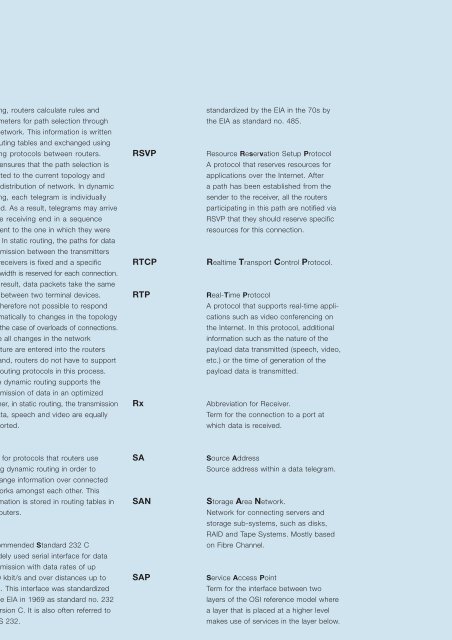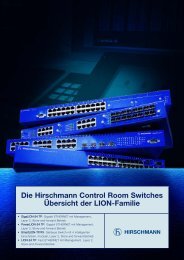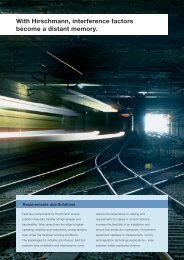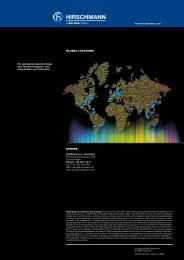Industrial ETHERNET
Industrial ETHERNET
Industrial ETHERNET
- No tags were found...
Create successful ePaper yourself
Turn your PDF publications into a flip-book with our unique Google optimized e-Paper software.
outing, routers calculate rules and<br />
parameters for path selection through<br />
the network. This information is written<br />
to routing tables and exchanged using<br />
routing protocols between routers.<br />
This ensures that the path selection is<br />
adapted to the current topology and<br />
load distribution of network. In dynamic<br />
routing, each telegram is individually<br />
routed. As a result, telegrams may arrive<br />
at the receiving end in a sequence<br />
different to the one in which they were<br />
sent. In static routing, the paths for data<br />
transmission between the transmitters<br />
and receivers is fixed and a specific<br />
bandwidth is reserved for each connection.<br />
As a result, data packets take the same<br />
path between two terminal devices.<br />
It is therefore not possible to respond<br />
automatically to changes in the topology<br />
or in the case of overloads of connections.<br />
Since all changes in the network<br />
structure are entered into the routers<br />
by hand, routers do not have to support<br />
any routing protocols in this process.<br />
While dynamic routing supports the<br />
transmission of data in an optimized<br />
manner, in static routing, the transmission<br />
of data, speech and video are equally<br />
supported.<br />
RSVP<br />
RTCP<br />
RTP<br />
Rx<br />
standardized by the EIA in the 70s by<br />
the EIA as standard no. 485.<br />
Resource Reservation Setup Protocol<br />
A protocol that reserves resources for<br />
applications over the Internet. After<br />
a path has been established from the<br />
sender to the receiver, all the routers<br />
participating in this path are notified via<br />
RSVP that they should reserve specific<br />
resources for this connection.<br />
Realtime Transport Control Protocol.<br />
Real-Time Protocol<br />
A protocol that supports real-time applications<br />
such as video conferencing on<br />
the Internet. In this protocol, additional<br />
information such as the nature of the<br />
payload data transmitted (speech, video,<br />
etc.) or the time of generation of the<br />
payload data is transmitted.<br />
Abbreviation for Receiver.<br />
Term for the connection to a port at<br />
which data is received.<br />
Routing<br />
Protocol<br />
RS 232 C<br />
Term for protocols that routers use<br />
during dynamic routing in order to<br />
exchange information over connected<br />
networks amongst each other. This<br />
information is stored in routing tables in<br />
the routers.<br />
Recommended Standard 232 C<br />
A widely used serial interface for data<br />
transmission with data rates of up<br />
to 20 kbit/s and over distances up to<br />
15 m. This interface was standardized<br />
by the EIA in 1969 as standard no. 232<br />
in Version C. It is also often referred to<br />
as RS 232.<br />
SA<br />
SAN<br />
SAP<br />
Source Address<br />
Source address within a data telegram.<br />
Storage Area Network.<br />
Network for connecting servers and<br />
storage sub-systems, such as disks,<br />
RAID and Tape Systems. Mostly based<br />
on Fibre Channel.<br />
Service Access Point<br />
Term for the interface between two<br />
layers of the OSI reference model where<br />
a layer that is placed at a higher level<br />
makes use of services in the layer below.<br />
RS 422 Recommended Standard 422<br />
A serial interface for data transmission<br />
in full duplex operation. This interface<br />
was standardized in the 70s by the EIA<br />
as standard no. 422.<br />
SC<br />
Straight Connector<br />
A widely used plug connector for fiber<br />
optic cables. Also see DSC.<br />
RS 485 Recommended Standard 485<br />
A serial interface for data transmission<br />
that enables a bus structure with<br />
several partici-pants. This interface was<br />
277











